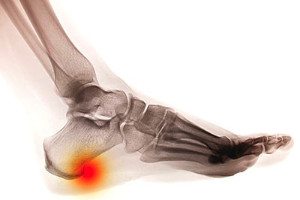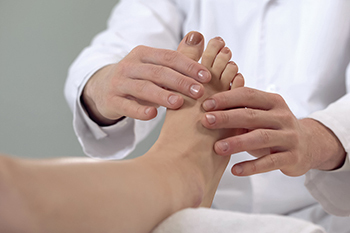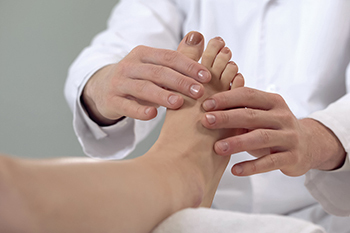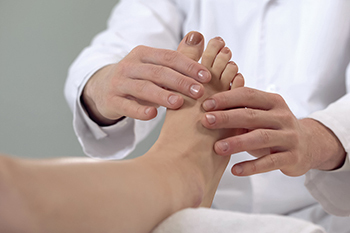Items filtered by date: September 2022
We Can Treat Your Foot or Ankle Pain
A Heel Spur May Be Misdiagnosed

As small as a heel spur is, it can bring severe pain and discomfort to the patient. It is a bony protrusion that may be pointed and is found underneath the heel. It is a calcium build-up, and can gradually come from wearing shoes that do not fit correctly. Many times a heel spur may be misdiagnosed as plantar fasciitis, which is another condition that affects the heel. A diagnosis consists of undergoing an examination that can determine how tender the heel is, in addition to possibly having an X-ray taken. There are patients who find mild relief when anti-inflammatory medications are taken, despite being a temporary fix. Another option that may be considered are custom-made orthotics, and these may help to diminish pressure on the Achilles tendon. If you have heel pain, it is strongly suggested that a podiatrist is consulted who can determine what the cause is, and offer correct treatment options.
Heel spurs can be incredibly painful and sometimes may make you unable to participate in physical activities. To get medical care for your heel spurs, contact Anas Khoury, DPM from North Eastern Foot & Ankle Specialists. Our doctor will do everything possible to treat your condition.
Heels Spurs
Heel spurs are formed by calcium deposits on the back of the foot where the heel is. This can also be caused by small fragments of bone breaking off one section of the foot, attaching onto the back of the foot. Heel spurs can also be bone growth on the back of the foot and may grow in the direction of the arch of the foot.
Older individuals usually suffer from heel spurs and pain sometimes intensifies with age. One of the main condition's spurs are related to is plantar fasciitis.
Pain
The pain associated with spurs is often because of weight placed on the feet. When someone is walking, their entire weight is concentrated on the feet. Bone spurs then have the tendency to affect other bones and tissues around the foot. As the pain continues, the feet will become tender and sensitive over time.
Treatments
There are many ways to treat heel spurs. If one is suffering from heel spurs in conjunction with pain, there are several methods for healing. Medication, surgery, and herbal care are some options.
If you have any questions feel free to contact our office located in Passaic, NJ . We offer the latest in diagnostic and treatment technology to meet your needs.
What Can Contribute to Ankle Pain?

Anyone who has experienced ankle pain is often aware of the difficulty this may cause while attempting to complete daily activities. The function of the ankle is to provide balance and stability to the body, and there are several bones, ligaments, and tendons that are found within it. Research has indicated it is the bone in the body that is injured most frequently, and it can happen from overuse, or a running injury. It can also occur while stepping off of a curb or uneven surface, which can stretch the ankle beyond its normal range of motion. It is suggested that people who enjoy participating in sporting activities perform strengthening ankle stretches and exercises, and this may help to provide proper conditioning. There may be existing medical conditions that can affect the ankle. These include osteoarthritis, rheumatoid arthritis, or post-traumatic arthritis. It may be difficult to put any weight on the ankle, and walking may be difficult or impossible to do. Ankle discomfort is not a normal ailment to have, and if you are experiencing this type of pain, it is strongly advised that you consult with a podiatrist who can determine what the source is, and treat it accordingly.
Ankle pain can be caused by a number of problems and may be potentially serious. If you have ankle pain, consult with Anas Khoury, DPM from North Eastern Foot & Ankle Specialists. Our doctor will assess your condition and provide you with quality foot and ankle treatment.
Ankle pain is any condition that causes pain in the ankle. Due to the fact that the ankle consists of tendons, muscles, bones, and ligaments, ankle pain can come from a number of different conditions.
Causes
The most common causes of ankle pain include:
- Types of arthritis (rheumatoid, osteoarthritis, and gout)
- Ankle sprains
- Broken ankles
- Achilles tendinitis
- Achilles tendon rupture
- Stress fractures
- Bursitis
- Tarsal tunnel syndrome
- Plantar fasciitis
Symptoms
Symptoms of ankle injury vary based upon the condition. Pain may include general pain and discomfort, swelling, aching, redness, bruising, burning or stabbing sensations, and/or loss of sensation.
Diagnosis
Due to the wide variety of potential causes of ankle pain, podiatrists will utilize a number of different methods to properly diagnose ankle pain. This can include asking for personal and family medical histories and of any recent injuries. Further diagnosis may include sensation tests, a physical examination, and potentially x-rays or other imaging tests.
Treatment
Just as the range of causes varies widely, so do treatments. Some more common treatments are rest, ice packs, keeping pressure off the foot, orthotics and braces, medication for inflammation and pain, and surgery.
If you have any questions, please feel free to contact our office located in Passaic, NJ . We offer the newest diagnostic and treatment technologies for all your foot care needs.
Foot Wounds and Diabetic Ulcers May Lead To Amputation

The amount of lower limb amputations is at an increased rate, and this is especially true of diabetic patients. High blood levels and poor glucose management can significantly contribute to the onset of diabetes which can lead to the amputation of a toe or a leg. An unnoticed cut on the bottom of the foot may lead to an infection that grows into a diabetic foot ulcer. This can be from the inability to heal properly, in addition to not keeping the weight off of the foot. There are methods that can be implemented which can help to eliminate the need for amputation. These can include controlling the body’s sugar levels, and having regular foot assessments performed by a podiatrist. Research has indicated this may help to reduce the risk of developing a foot ulcer by approximately 50%, which can lead to possible prevention of amputation. If you have diabetes, it is strongly suggested that you are under the care of a podiatrist, who can help you to properly manage this condition, and guide you toward methods in controlling your blood sugar.
Diabetic Limb Salvage
Diabetic limb salvage can be an effective way in preventing the need for limb amputation. If you have a foot ulcer and diabetes, consult with Anas Khoury, DPM from North Eastern Foot & Ankle Specialists. Our doctor will assess your condition and provide you with quality foot and ankle treatment.
What Is Diabetic Limb Salvage?
Diabetic limb salvage is the attempt of saving a limb, such as the foot, that has an infected ulcer, from amputation. Podiatrists also try to make sure that there is enough function in the foot after the salvage that it is still usable. Those with diabetes experience poor blood circulation, which prevents proper healing of an ulcer. If the ulcer is left uncheck, it could become infected, which could result in the need for amputation.
Diabetes is the number one cause of non-traumatic amputations in the United States. Amputation has been found to lead to higher mortality rates. This translates into higher healthcare costs, and a reduced quality of life and mobility for amputees. Podiatrists have attempted to increase the prevalence of limb salvage in an attempt to solve these issues.
Diagnosis and Treatment
Limb salvage teams have grown in recent years that utilize a number of different treatments to save the infected limb. This includes podiatrists that specialize in wound care, rehabilitation, orthotics, and surgery. Through a combination of these methods, limb salvage has been found to be an effective treatment for infected limbs, and as an alternative to amputation. Podiatrists will first evaluate the potential for limb salvage and determine if the limb can be saved or must be amputated.
If you have any questions, please feel free to contact our office located in Passaic, NJ . We offer the newest diagnostic and treatment technologies for all your foot care needs.
Pinky Toe Ingrown Toenails

An ingrown toenail is a potentially painful and unsightly condition that usually affects the big toe. This condition occurs when the side of the toenail grows into the skin, creating redness and swelling in the affected area. However, it is also possible for an ingrown toenail to develop on the pinky toe. This can be problematic for several reasons. Most notably, the pinky toe is the smallest of all the toes, which makes taking proper care of the pinky toenail difficult. Many individuals can not properly trim or cut this toenail due to its small size, which is a leading cause of ingrown toenails. For example, toenails that are cut too short or in a misshapen way can develop into ingrown toenails. A good way to prevent this from happening to your pinky toes is to cut the toenail straight across. This can prevent the nail from growing into the skin. Another helpful method of prevention is to wear shoes that do not crowd the toes and offer sufficiently large toe boxes. The pinky is certainly a small and often neglected part of the human body. However, having an ingrown toenail on your pinky toe is nothing to take lightly. Reach out to your local podiatrist to learn more about treating your ingrown toenail.
Ingrown toenails can become painful if they are not treated properly. For more information about ingrown toenails, contact Anas Khoury, DPM of North Eastern Foot & Ankle Specialists. Our doctor can provide the care you need to keep you pain-free and on your feet.
Ingrown Toenails
Ingrown toenails occur when a toenail grows sideways into the bed of the nail, causing pain, swelling, and possibly infection.
Causes
- Bacterial infections
- Improper nail cutting such as cutting it too short or not straight across
- Trauma to the toe, such as stubbing, which causes the nail to grow back irregularly
- Ill-fitting shoes that bunch the toes too close together
- Genetic predisposition
Prevention
Because ingrown toenails are not something found outside of shoe-wearing cultures, going barefoot as often as possible will decrease the likeliness of developing ingrown toenails. Wearing proper fitting shoes and using proper cutting techniques will also help decrease your risk of developing ingrown toenails.
Treatment
Ingrown toenails are a very treatable foot condition. In minor cases, soaking the affected area in salt or antibacterial soaps will not only help with the ingrown nail itself, but also help prevent any infections from occurring. In more severe cases, surgery is an option. In either case, speaking to your podiatrist about this condition will help you get a better understanding of specific treatment options that are right for you.
If you have any questions please feel free to contact our office located in Passaic, NJ . We offer the newest diagnostic and treatment technologies for all your foot and ankle needs.

